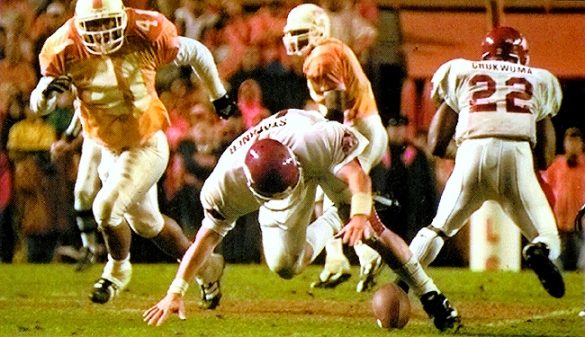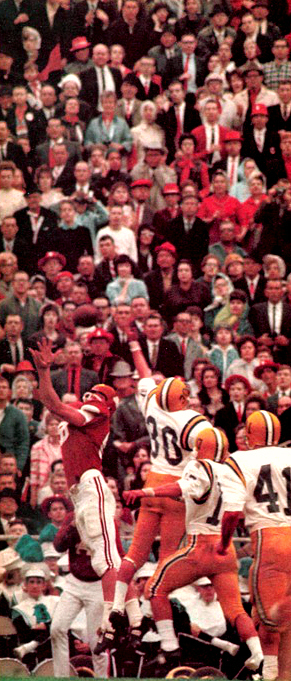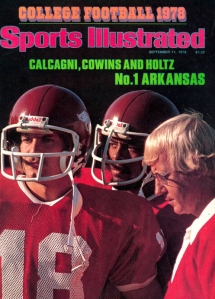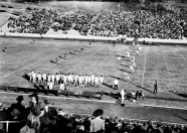
In light of the Razorbacks’ current season, which began with great expectations and was derailed yet again by a grueling SEC schedule, it seems appropriate to reflect on past seasons when the flicker of championship glory was brutally extinguished.
There’s a lot of heartbreak in this list. Better grab some tissues.
10. 1998 — The Stoernover
After five years with Danny Ford at the helm, Arkansas severed ties with its head coach and brought in Houston Nutt. An Arkansas native and former Razorback, Nutt was handed a veteran squad, and the season couldn’t have started any better.
The Hogs roared out of the gate to an 8-0 start, rolling No. 22 Alabama in the SEC opener and winning three straight road games. No. 11 Arkansas then breezed past Ole Miss to set up a monumental showdown against No. 1 Tennessee in Knoxville.
Now ranked No. 10, Arkansas jumped on the Vols early, leading 21-3 in the first half. But Tennessee clawed back to pull within two — 24-22 — with about three minutes remaining. The Hogs tried to run out the clock, but disaster struck when quarterback Clint Stoerner tripped over his lineman’s foot and fumbled the ball. Tennessee recovered and scored the winning touchdown five plays later.
Still, Arkansas wasn’t out of the national title hunt. The Hogs actually moved up in the rankings after losing to Tennessee, improving to No. 9. But a week later the shell shocked Razorbacks were upended 22-21 by Mississippi State on a dubious field goal.
Tennessee, meanwhile, went on to win the first BCS National Championship.
9. 1979 — New Year’s Day Debacle
The Razorbacks were in a peculiar position at the end of the ’79 season. Although the Hogs lost their bowl game to the eventual national champion, it’s plausible that had Arkansas prevailed, it still wouldn’t have finished No. 1.
The season in a nutshell: Despite beating Texas for the first time in eight years and reaching as high as No. 4 in the polls, Arkansas’ title hopes were dashed by No. 6 Houston. Later in the season Texas knocked off Houston, but both the Cougars and Hogs finished 7-1 to share the SWC title.
No. 6 Arkansas was invited to the Sugar Bowl while Houston went to the Cotton Bowl. The Hogs were paired with No. 2 Alabama. The Crimson Tide, SEC champions and undefeated at 11-0, steamrolled Arkansas 24-9 to win their seventh and final championship under legendary coach Paul “Bear” Bryant.
Although Houston won the Cotton Bowl, the Cougars had dropped a few spots — to No. 8 — entering the game. Already ahead in the polls, Arkansas further benefited when No. 1 Ohio State lost in the Rose Bowl.
But that victory came thanks to No. 2 Southern California. Meanwhile, No. 5 Oklahoma topped No. 4 Florida State in the Orange Bowl.
So, it’s safe to assume even if the Hogs managed to upset Alabama, the best they could hope for was a top five finish in the polls.
Plus, even if Alabama lost, the Tide probably would just claim the title anyway.
8. 1988 — Help Wanted
By the late 1980s, the SWC was still recovering from SMU’s pay-for-play scandal that destroyed the Mustangs’ football program. Arkansas, despite being 10-0 with wins over Ole Miss, Texas and Houston — the latter two victories coming on the road — was only ranked No. 8 heading into the season finale against No. 3 Miami.
As noted by Arkansas Fight, the SWC’s sordid reputation and a distaste for smashmouth football among the national media possibly contributed to the Hogs’ low ranking:
“[Sports Illustrated] paints a dismal picture of the ’88 Hogs, focusing on their performance in the Arkansas-Texas A&M game that … ‘was about as pretty to look at as the snarling wild pig emblem that decorates gas stations and convenience stores all across Arkansas'”
Heading into the game with Miami, Arkansas also was looking to avenge its 51-7 shellacking from the Hurricanes the year before in Little Rock. But to win the national title, Arkansas would need loads of help from other teams and the media, as CBS pointed out in its pre-game show.
Down in the Orange Bowl for the ’88 contest, the two teams traded blows until late in the second half, when Arkansas safety Steve Atwater came achingly close to making a game-clinching interception.
Miami settled for a field goal, but that was enough to edge the Hogs 18-15. While a win over Miami wouldn’t have guaranteed Arkansas a national title, it would’ve tipped the scales in the Razorbacks’ favor. But losing to Troy Aikman and No. 9 UCLA in the Cotton Bowl didn’t help, either.
7. 1977 — “The national championship is up for grabs!”
For most of Arkansas’ tenure in the SWC, the Razorbacks’ biggest hurdle each year was Texas. The 1977 season wouldn’t be any different.
After a perplexing 5-5-1 finish in ’76, Arkansas rebounded in ’77 with a stellar cast that included future NFL Hall of Fame inductee Dan Hampton. The Hogs were 4-0 and ranked No. 8 when No. 2 Texas rolled into Fayetteville.
A match-up of two undefeated teams, the game was a defensive slugfest. Early scores hinged on field goals, which included a then-record 67-yard blast from Arkansas’ Steve Little.
But Texas’ backbreaking, 80-yard touchdown drive in the fourth quarter sealed a 13-9 Longhorns victory.
Arkansas won the rest of its games and finished second in the SWC, earning an invite to the Orange Bowl. Texas, meanwhile, won the SWC and earned a trip to the Cotton Bowl.
Down in Miami, Arkansas blasted No. 2 Oklahoma 31-6. Earlier, in Dallas, the Longhorns were whipped 38-10 by Joe Montana and No. 5 Notre Dame. If the Sooners won, they could have a shot at a national title.
But thanks to an upset in the Rose Bowl and a lopsided win by Alabama in the Sugar Bowl, there wouldn’t be a clear national champion. Despite division within the AP and UPI polls, Notre Dame received a majority of No. 1 votes. Today, the Fighting Irish are widely recognized as the national champions of 1977.
Still, it’s worth noting that Alabama and Arkansas also received a share of No. 1 votes — with the Hogs tallying 5 1/2 votes in the AP poll and two votes in the UPI poll.
6. 1982 — “Damn Texas refs”
Under six-year head coach Lou Holtz, the Hogs were ranked No. 13 in the 1982 preseason and climbed to No. 5 after a 7-0 start. Arkansas was upset late in the year by Baylor, but crept back into the top 10 after drubbing Texas A&M 35-0 in Little Rock.
Up next for the No. 9 Hogs was a trip to Dallas to face No. 2 SMU. The Mustangs were undefeated and had a chance to win the SWC that afternoon in Texas Stadium.
Led by Billy Ray Smith, Jr., Arkansas’ defense slowed the vaunted “Pony Express,” and the Hogs were nursing a 17-10 lead late in the fourth quarter.
With just over four minutes remaining, SMU faced a third-and-long. Short on time, Mustangs quarterback Lance McIlhenny dropped back and hurled a prayer downfield to receiver Jackie Wilson.
The rest is sordid history — to Hogs fans, at least.
Nathan Jones, Arkansas’ sophomore defensive back, was whistled for pass interference despite the ball being overthrown and Wilson climbing up Jones’ back.
The penalty awarded the Mustangs a 40-yard gain, putting SMU in the red zone. SMU scored a few plays later on McIlhenny’s scramble, held Arkansas on defense, and missed a kick in the final seconds to preserve the tie.
The 17-17 stalemate clinched the SWC for SMU and secured the Mustangs a Cotton Bowl berth, where they beat Dan Marino and No. 6 Pittsburgh.
Now ranked No. 6, Arkansas followed the loss to SMU with a 33-7 whipping from No. 12 Texas. The Hogs limped to the Bluebonnet Bowl just weeks removed from being in the hunt for a national title.
But Razorbacks fans got some pretty cool bumper stickers out of the fiasco.
5. 2006 — “The lost year”
Houston Nutt’s most successful season also was his most tumultuous.
The season seemed like a lost cause from the outset, when star running back Darren McFadden injured his toe in a night club brawl in Little Rock.

Houston Nutt was hired as Arkansas’ head coach in 1998. Over the next eight years, he moonlighted as the offensive coordinator.
Meanwhile, Gus Malzahn had been hired as offensive coordinator. A legend in the Arkansas high school ranks, Malzahn brought with him a handful of his elite players, including former Springdale quarterback Mitch Mustain, the 2005 Gatorade National Player of the Year.
Malzahn’s offensive scheme — described as a “before-its-time, no-huddle spread offense” — immediately clashed with Nutt’s conservative play calling.
The rift deepened thanks to a brewing quarterback controversy between Mustain and starter Casey Dick, and Nutt’s reluctance to give up play-calling duties — something he oversaw during his previous eight years at Arkansas.
Arkansas got smoked in the season opener against No. 6 USC, but reeled off 10 straight wins. McFadden emerged as a Heisman candidate, and his two teammates in the backfield — Felix Jones and Peyton Hillis — became stars in their own right.
The Hogs were ranked No. 5 and had already clinched the SEC West when No. 9 LSU came to War Memorial Stadium for the first top 10 matchup in the history of the Battle for the Golden Boot.

Despite a record-setting career at Springdale High School, quarterback Mitch Mustain and offensive coordinator Gus Malzahn couldn’t replicate their success at Arkansas.
LSU won 31-26 thanks to a flurry of big plays and questionable offensive play-calling from Arkansas.
From there, the Hogs went to Atlanta to play No. 4 Florida in the SEC Championship Game, where they blew a four-point lead late in the third quarter. The back-breaker came when Arkansas receiver Reggie Fish tried to field a punt near the Hogs’ goal line, muffed the ball, and Florida recovered it in the end zone for a touchdown.
The Hogs capped the season with an agonizing loss to No. 6 Wisconsin in the Capital One Bowl.
The 1970 Razorbacks got off to an auspicious start. Arkansas was one of several schools to take advantage of a new NCAA rule allowing teams to schedule an 11th game. Other high-profile regular season matchups that year included LSU-Notre Dame, USC-Alabama and UCLA-Texas.
But as the New York Times noted, “the national spotlight will be at Little Rock, where Arkansas opposes Stanford” on national TV.
No. 10 Stanford jumped on the Hogs early, taking a 21-0 lead in the first quarter. Arkansas, ranked No. 4, rallied but fell short in the second half, as Stanford won 34-28.
Still, Arkansas returned a talented, senior-laden roster. The Razorbacks followed the loss by dismantling Oklahoma State and Tulsa, then ran roughshod through the SWC. After thumping No. 19 Texas Tech in Lubbock, the Hogs were back in the top 5 and heading to Austin for a showdown against No. 1 Texas.
It was the Big Shootout all over again: The winner of the 1970 contest would clinch the SWC and possibly a share of the national title. The Waco Tribune-Herald succinctly captured Arkansas’ pre-game misery:
“Last year’s tears, suffered on that cold, dismal day in Fayetteville have lingered for an entire season.”
But Arkansas wouldn’t exact revenge for ’69. And there was no dramatic finish — or much excitement at all — as the Longhorns skewered the Hogs 42-7.
3. 2011 — Bayou Beatdown
Despite being thumped by Alabama earlier in the year, the Hogs were within arms reach of the title game at the end of the 2011 season.
Thanks to a bevy of upsets and the Razorbacks’ “thrashing” of Mississippi State, the Battle for the Golden Boot became a top 5 match-up with massive postseason implications. Arkansas had jumped in the polls from No. 6 to No. 3 — the Hogs’ highest ranking since 1978 — while LSU and Alabama held the top two spots, respectively.
Meanwhile, the Arkansas-LSU rivalry had emerged on the national stage. Six of the previous seven games had been decided by an average of 3.5 points.
After a scoreless first quarter in Death Valley, Arkansas appeared in control, bolting to a 14-0 lead. But the Tigers responded with a 77-yard scoring drive, held the Hogs on defense, and then returned the punt 92 yards for a touchdown.
The rout was on from there, with LSU outscoring Arkansas 27-3 the rest of the way.
2. 1969 — Game of the Century
What wasn’t at stake on Dec. 6, 1969?
For Arkansas and Texas, it was the final regular-season game of the 100th anniversary of college football. The winner would claim the SWC title, a berth in the Cotton Bowl, and be declared national champions by the U.S. president — who was watching from the stands.
Despite dreary conditions, Razorback Stadium was filled to capacity, while 58 million watched on TV.
The annual match-up between the Longhorns and Razorbacks functioned as a one-game referendum on a budding rivalry, a fact that was overlooked amidst all the chaos surrounding the game.
Texas was Arkansas’ most hated opponent, but the feeling wasn’t mutual. Still, Arkansas and Texas shared or won the SWC eight times in the 1960s. The average margin of victory between the two teams in their previous nine meetings was a paltry seven points.
By ’69, outsiders had taken notice. What was later coined The Big Shootout originated from the foresight of TV executives, who lobbied Arkansas and Texas to move their usual October meeting to December for the final game of the season.
The gamble paid off: the Longhorns and Hogs entered the game undefeated — ranked No. 1 and No. 2, respectively — and ABC had the ratings bonanza it hoped for.
Even the weather played along with the melodrama:
“[T]he day took on an eerie feeling. The night before, a steady, cold rain fell in Fayetteville and an icy fog hovered over the stadium as the crowd awaited the arrival of President Richard Nixon, who would award a plaque symbolic of the National Championship to the winner.”

Texas quarterback James Street’s 42-yard touchdown run in the fourth quarter was a seminal moment in The Big Shootout.
Arkansas fans know well the heartbreak of the game. The Hogs looked unstoppable early, but blew a 14-0 lead and lost 15-14 to the hated Longhorns. Texas celebrated in the locker room with President Nixon, who presented a national championship plaque to the Longhorns.
Texas went on to defeat Notre Dame in the Cotton Bowl to finish 11-0. The Longhorns, alongside Ohio State and Nebraska, were later named national champions by the National Football Foundation and UPI. The Hogs, meanwhile, ended up in the Sugar Bowl, where they were upset by Archie Manning and Ole Miss.
Losing to Texas crushed Razorbacks fans, but the long-term ramifications wouldn’t be fully realized until the 1980s.
Before Frank Broyles arrived, Arkansas was second-fiddle not only to Texas, but most of the SWC. That all changed in the 1960s. By the end of the decade, Arkansas had established a program to rival Texas. Losing the Big Shootout loomed over the program for the next few seasons, while Texas prospered.
The Longhorns opened the 1970s by winning four straight conference titles and dominated Arkansas as the rivalry reverted to a one-sided affair. Arkansas beat Texas just twice in the decade (’71 and ’79), while losing eight times by an average of 25 points.
1. 1965 — “It had to end sometime”
The last time Arkansas was on the cusp of a national title, the Hogs were riding a 22-game win streak, ranked No. 2 in the country and facing an over-matched LSU team in the Cotton Bowl.

LSU’s 14-7 upset over No. 2 Arkansas in the 1966 Cotton Bowl kept the Hogs from winning consecutive national titles.
But the Razorbacks were undone by their own hubris and a feisty Tigers squad.
As Sports Illustrated noted before the game, Broyles knew his team souldn’t overlook LSU:
“A lady whose intention undoubtedly was kind wove through the balloons and paper hats at the Cotton Bowl New Year’s Eve party and clutched the arm of Arkansas Coach Frank Broyles. ‘Frank,’ she said, ‘you have nothing to worry about tomorrow,’ meaning the Razorbacks were certain to beat Louisiana State for their 23rd straight win. ‘Lady,’ said Broyles, ‘that is exactly what worries me.'”
Arkansas went up 7-0 in the opening quarter, the only score of the period. But the Hogs couldn’t contain Joe Labruzzo, LSU’s bruising running back. He scored both of the Tigers’ touchdowns and captured MVP honors.
Neither team scored in the second half and Arkansas’ last-second rally was extinguished when the clock ran out.
Thanks to losses by No. 1 Michigan State and No. 2 Nebraska, LSU’s victory inadvertently vaulted No. 4 Alabama to the national title. Arkansas finished at No. 3.
Had Arkansas won, the Razorbacks would’ve not only had a strong case for being known as “the team of the ’60s,” but the ’64 and ’65 squads would be regarded as two of the all-time best in the annals of college football.
Honorable Mention
A total of six points kept Arkansas from an undefeated regular season in 1985.

After a strong finish in ’77, Sports Illustrated ranked Arkansas as the No. 1 team heading into the 1978 season.
The Razorbacks opened the season 5-0 and were ranked No. 4 when an underachieving Texas squad came to Fayetteville on Oct. 19. Arkansas scored first and held the Longhorns without a touchdown, but succumbed 15-13 thanks to five Texas field goals.
Roughly three weeks later, the SWC title was up for grabs when No. 9 Arkansas traveled to College Station. Texas A&M pulled the upset, 10-6.
Arkansas rebounded, though, with a thrilling victory in the Holiday Bowl.
Just seven years earlier, Arkansas graced the cover of Sports Illustrated as the magazine’s No. 1 team entering the 1978 season. The Hogs also were blessed with a No. 2 ranking from the Associated Press.
The Hogs picked up where they left off from ’77, but consecutive losses to No. 8 Texas and No. 11 Houston spoiled Arkansas’ championship aspirations.
























































